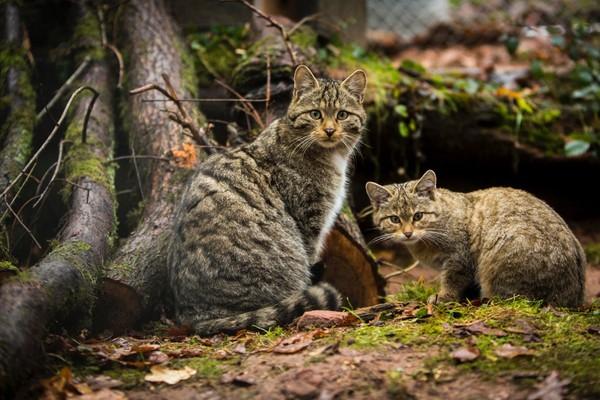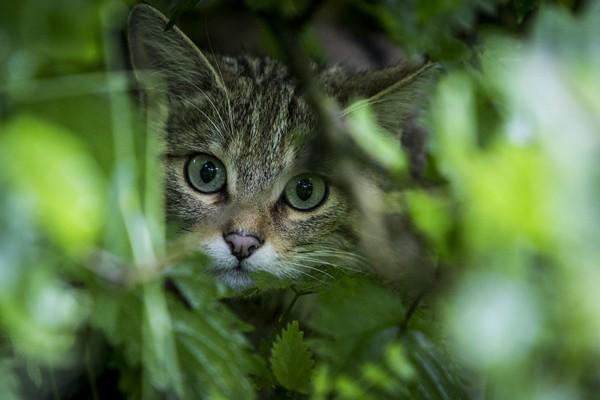
About European Wildcats – Also Called "Felis Silvestris Silvestris"
The small cat is on the red list of Germany
Adult wildcats have dense fur, which is somewhat longer-haired compared to domestic cats, with a grayish-yellow ground colour, blurred tiger markings and a white throat patch. This usually makes them look bigger and stouter, although wildcats and domestic cats hardly differ in body size. The drawing is still much more contrasting in young wildcats, so that these are often confused with wild domestic cats.
From the forehead up to six dark stripes extend between the ears to the nape of the neck. A dark stripe behind the shoulders expands into a spinal stripe running up to the base of the tail in wildcats, while it extends over the entire tail in wild domestic cats. The bushy tail of adult wildcats is bushy with two to three black, transverse rings and rounded at the black tip.
Other characteristics of the wildcat include a pink nose and strong white whiskers.
Scientific classification
| Order | Carnivora |
| Suborder | Feliformia |
| Family | Felidae |
| Subfamily | Felinae |
| Genus | Felis |
| Species | Felis silvestris |
| Subspecies | European wildcat Felis silvestris silvestris |
| Binominal name | Felis silvestris silvestris (Schreber, 1777) |
| Red list Germany | endangered |
The European wildcat - animal of the year 2018!
In 2018, the German Wildlife Foundation (Deutsche Wildtierstiftung) elected the European wildcat to the "Animal of the Year". The need for protection of the species should be brought into the focus of the public. After wildcats had almost completely disappeared from the forests. Since then, several thousand wildcats live in Germany again today – especially in the low mountain regions such as the Palatinate Forest. Nevertheless, the nocturnal solitary animals are still considered "endangered" (Red List Germany).
Did you know…?
What is the lifestyle of a wildcat?
Wildcats are extremely shy and avoid human contact whenever possible. They live hidden in structurally rich broadleaf and mixed forests, where they sleep hidden in tree hollows, brushwood piles or rock crevices during the day. Wildcats are active at dusk and at night. In the darkness, the sneak hunters go hunting for prey. They eat mainly mice, but occasionally also frogs, lizards, insects or small birds.
Outside the mating season between January and March, wildcats live solitary lives. The size of their foraging areas averages between 2 and 9 square kilometers per animal and is strongly related to the availability of prey and hiding places. The males' territories usually encompass territories of several females and are expanded during the mating season in search of females willing to mate.
After a gestation period of 63 to 69 days, 2 to 4 kittens are usually born. Most litters occur in April, but kittens are born as late as September. It is not uncommon for wildcats to have a second litter in the fall if the spring litter was lost to predators for example.
What threats does the wildcat face?
The preferred habitat of the European wildcat is characterized by structurally rich deciduous and mixed forests with sufficient deadwood, as well as tree and rock cavities, in which the shy animals find daytime hiding places and safe places to raise their young. Unfortunately, such forest areas are becoming increasingly rare or more and more fragmented. Large, contiguous forest areas are becoming increasingly dissected, making it difficult for the shy wildcat to migrate and disperse between them. In many regions, the increasing spread of open farmland is making it difficult for them to conquer new areas because of the lack of migration corridors with cover provided by trees and bushes between individual forest zones.
Crossing aids in the dense road network are also largely lacking. Especially during the main activity phase at dusk and night, wildcats are often run over when crossing main roads and highways during their migrations between individual forest areas. It is not uncommon that wildcats are run over again and again in the same place, since the animals orient themselves during their migrations by the scent marks of their conspecifics. Victims are mostly young cats in search of their own territory.

Wildcat or domestic cat? Young animals are often 'collected' without reason
Often the kittens are mistaken for abandoned domestic cats, collected out of unawareness and finally brought to the animal shelter. The extremely shy wildcat generally strictly avoids contact with people and towns. However, it happens that the mothers hide their kittens in wooden poles in gardens or leave them alone in the bushes at the edge of the forest while they go hunting for prey. It is not uncommon for walkers to discover the young ones and assume that they need help because they may no longer be cared for by their mothers or may even have been abandoned. With their dark stripe markings on an ocher background, the kittens strongly resemble similarly colored domestic cats. However, the similarity is deceptive!
The European wildcat is by no means a wild domestic cat, but an individual species. Our domestic cat is derived from the African wildcat (Felis lybica) and was first brought to Europe by the Romans. Adult wildcats are hardly larger than domestic cats, but appear more massive due to the dense, longer fur. The typical stripe pattern with a dark line along the spine is similarly contrasting in young wild cats as in tabby domestic cats, but in adult animals it is rather blurred and often hardly recognizable as stripes. Also the prominent bushy tail with 2-3 dark rings and blunt end clearly distinguishes the adult wildcat from the domestic cat with its rather narrow and pointed ending tail.
In young wildcats, where the above characteristics are not yet so distinct, the color of the nose can also serve as an indication of their origin. While the nose color in domestic cats is often brownish or gray to black, in wild cats it is usually strikingly rosy or flesh-colored.
According to our experience, it is usually not the appearance, but rather the behavior, which ultimately raises the suspicion that the tabby foundlings could be wildcats. Even very young kittens usually defend themselves with fierce growling, hissing, spitting and biting against their 'helpers', who finally hand the little ones over to the animal shelter or to us – not infrequently covered with scratch wounds.
We urgently advise against the naively collection of young cats found alone. Most of the time the mother is looking for food nearby and returns to her offspring in regular intervals – but not as long as there are humans around.

Correct behavior when finding young or injured wildcats
If while walking, you come across young kittens that exhibit the typical wildcat characteristics mentioned above, please remain absolutely calm and quickly move away from their environment so as not to expose the animals to unnecessary stress. If you are in any way unsure about the situation, do not hesitate to seek expert advice and call a wildlife center, for example, before you act yourself and the animals are taken away from their mother for no reason in the worst case. Hand rearing by humans can never completely replace rearing by the mother!
In any case, please report injured animals to a nearby wildlife station or to the police, who can also identify and notify the responsible hunter or forester. Wildcats are strictly protected and may not be removed without an important reason from their natural environment!
TIERART takes in a large number of wildcats every year
Usually, the number of animals amounts to about 15-20 per year, but in 2020 there were even 36!
Even very young wildcats eat several hundred grams of mice per animal every day, and the amount of food required increases as the cats get bigger. Mice are extremely expensive at 33 €/kg. However, they are essential for the species-appropriate nutrition of wildcats.



